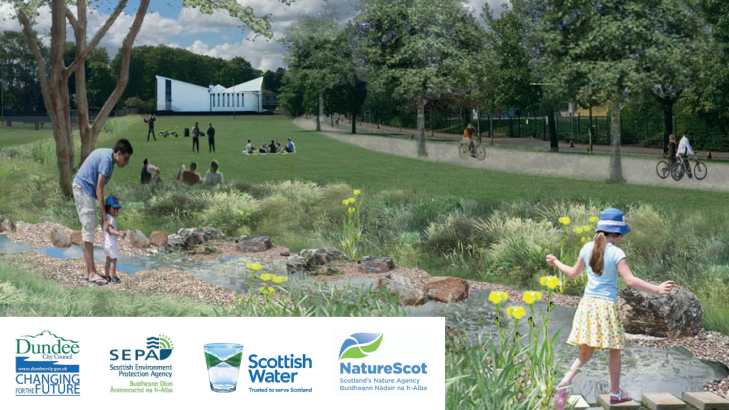Plans to reduce flooding in the Downfield area of Dundee using nature-based solutions have taken a firm step forward.
A feasibility study and outline design for the first phase of the St Leonard Park sustainable drainage project is now finalised and available to view, following extensive consultation with landscape architects, engineers and the local community. The work has been commissioned by a partnership of organisations including Scottish Water, Dundee City Council, and NatureScot.
The St Leonard Park project is the first phase of a storm water drainage strategy for the St Mary’s area of Dundee, developed jointly by Scottish Water and Dundee City Council in consultation with partners such as SEPA and NatureScot. The main focus is to reduce the risk of flooding in this area by introducing blue-green infrastructure – in other words, using the landscaped green spaces to collect and drain away surface water more naturally.
The strategy proposes to reinstate the historic Back Burn above ground in an area of greenspace alongside St Leonard Place, which floods regularly during periods of heavy rainfall. The area would be landscaped to allow this water to flow into the Dighty Burn, taking with it any excess surface water. This will then enable Scottish Water to disconnect surface water from the combined sewer, freeing up capacity in the system and significantly reducing the risk of flooding.
While flood prevention is the driver for these plans, the proposed management of water in greenspaces provides exciting opportunities to realise multiple benefits for people and nature. Enhancing the park with open water and additional planting will boost biodiversity, providing habitats for a range of insects, birds, mammals and amphibians. The park will also become a more attractive area for play and recreation, as well as encouraging walking, cycling and wheeling, enabling better, healthier access to schools and local amenities.
Dom McBennett from Scottish Water said: “This project has the potential to really transform the health and wellbeing of this whole community and it’s a really innovative approach to the problem of flooding and surface water management.
“Our strategy embraces new ways of partnership-based and multi-disciplinary working, combined with extensive stakeholder and community engagement. We’ve already carried out consultations with local residents and organisations and they’re telling us they’re very supportive of more nature- and water-rich urban green spaces.”
Scottish Water is adapting its approach to drainage, ensuring investments are resilient to climate change and in line with its routemap to reaching net zero carbon emissions by 2040. The St Marys project has the potential to set a precedent that demonstrates a holistic approach to over-ground surface water management, delivering climate resilience, biodiversity gain, urban functionality, health and well-being, and become an exemplar of a water-resilient place.
NatureScot Landscape Adviser Swaantje Ridegh said: “This project is an exciting example of how blue-green infrastructure can deliver multiple benefits for people and nature.
“By reducing the risk of flooding for the city of Dundee, it will also boost biodiversity by creating new habitats and improve health and wellbeing by providing new opportunities for residents to connect with nature and choose more sustainable and active travel.
“We hope that this project will provide a leading example of how planning for multifunctional greenspaces in our cities can help tackle the biodiversity loss and climate change crises we are facing, while delivering real benefits for people.”
Cllr Mark Flynn convener of Dundee City Council’s city development committee said: “We have been working closely with our partners to create increasingly innovative ways of addressing flooding issues faced by some of our communities that involve eco-positive solutions borrowed from nature.
“These will not only help to protect property and people in the future but also enhance the local environment and the way residents use it.”



